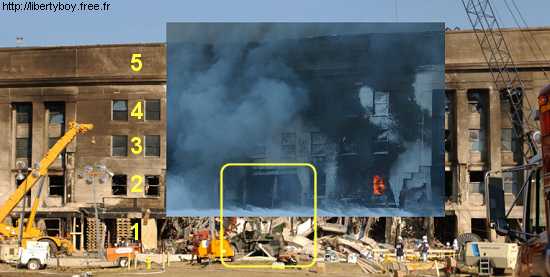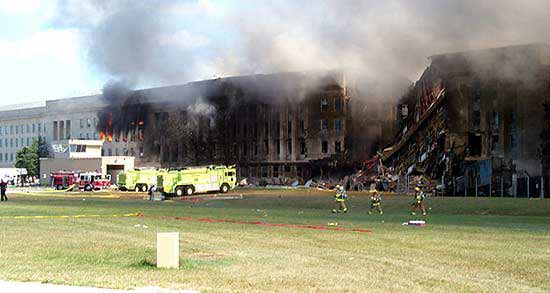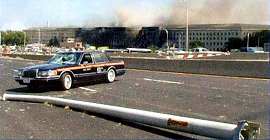|
Update (Feb. 2005).
Brian, one of the firefighters at the Pentagon on 9/11, has put together a page called
The September 11th Attack on the Pentagon.
Update (Sept. 2002).
In his books, Thierry Meyssan claims that no plane
crashed into the Pentagon on Sept. 11, 2001. After saying -- despite all evidence to the
contrary -- that only the first ring of the building was hit, he now claims that the first
three rings were damaged by a missile. He has yet to tell us what knocked down five light
poles. If you want to learn more about them, please visit Spot the Lamp Poles.

|
Thierry Meyssan of Réseau Voltaire, a French association close to far-left groups, wrote a book in which he claims no Boeing crashed into the Pentagon on September 11, 2001. Running in his father's footsteps, Raphaël Meyssan made a web page titled "Pentagon -- Hunt the Boeing! And test your perceptions!". Below, I have reproduced his seven questions, and answered them. Floors are numbered differently in different countries. In America, the ground floor is the first floor. In Britain and France, the floor above the ground floor is the first floor. In my answers, I have used the American numbering system. |
Question #1 
Image : Space Imaging

Image : U.S. Department of Defense
|  | The first satellite image shows the section of the building that was hit by the Boeing. In the image below, the second ring of the building is also visible. It is clear that the aircraft only hit the first ring. The four interior rings remain intact. They were only fire-damaged after the initial explosion. Can you explain how a Boeing 757-200, weighing nearly 100 tons and travelling at a minimum speed of 250 miles an hour* only damaged the outside of the Pentagon? *250 mph when landing, 600 mph in flight. |
|
Answer #1 
Exit hole where the plane stopped (Third ring). | These two pictures only show that the roofs were intact. They do not show that the other rings were not hit. In the second picture, the first and second floors of the second ring are not visible although it is precisely this part of the outer ring that was hit. In Meyssan's second picture, we can see the collapsed part of the building. In the picture on the left, the back wall is undamaged (except for the hole), nothing sticks out of the windows, and there is not much soot. Hence, this is not the outer ring's back wall, and so the plane did not only hit the first ring. Eyewitnesses saw a hole in the wall of the second ring. | 
Second ring. | 
Notice the black areas. |
Question #2 
Image : U.S. Marine Corps, Cpl. Jason Ingersoll

Image : U.S. Army
|  | The two photographs in question 2 show the building just after the attack. We may observe that the aircraft only hit the ground floor. The four upper floors collapsed towards 10.10 am. The building is 26 yards high. Can you explain how a Boeing 14.9 yards high, 51.7 yards long, with a wingspan of 41.6 yards and a cockpit 3.8 yards high, could crash into just the ground floor of this building?
|
|
Answer #2 Below is a section of the first picture pasted on a picture of the building. We clearly see that what Meyssan claims is the ground floor is actually the second floor. The building is five floors tall (the fifth floor does not have windows on the outer ring), and we can see three floors above the hole. Five minus three is two. |  |
|
Question #3 
Image : U.S. Army
The photograph above shows the lawn in front of the damaged building. You'll remember that the aircraft only hit the ground floor of the Pentagon's first ring. Can you find debris of a Boeing 757-200 in this photograph? |
|
Answer #3 Repeating endlessly that "the aircraft only hit the ground floor of the Pentagon's first ring" does not make it true. The plane did not hit only the ground floor (See Answer #2). As to the other rings not being damaged by the plane, it must be proven by showing that they were undamaged from the first floor to the fifth floor (See Answer #1). If you want to see debris, you just have to get a little closer. | | | | | | A tire. ("tyre" in British English) | |
| |
Question #4 
|  | The photograph in question 4 shows a truck pouring sand over the lawn of the Pentagon. Behind it a bulldozer is seen spreading gravel over the turf. Can you explain why the Defence Secretary deemed it necessary to sand over the lawn, which was otherwise undamaged after the attack? |
|
Answer #4 | This is standard procedure. They built a road to prevent the heavy equipment from getting bogged down. | |
Question #5 
Image : Space Imaging
|  | 
Image : U.S. Department of Defense, Sgt. Rudisill
The photographs in Question 5 show representations of a Boeing 757-200 superimposed on the section of the building that was hit. Can you explain what happened to the wings of the aircraft and why they caused no damage? |
|
Answer #5 
The plane was tilted at an angle of about 45.
What happened to this light pole? | Unlike Meyssan, I have not become an overnight expert on planes crashing into concrete-brick-limestone walls reinforced with steel. Hence, I cannot answer the question. Some people say the wings were probably pushed towards the fuselage. The plane is not in the right position: Eyewitnesses said it was tilted at an angle of about 45 degrees.
Did hundreds of people lie? The Pentagon staff, firefighters, air-traffic controllers at Reagan National Airport and Dulles International Airport, elevated-railway passengers, people on the highway, people living nearby, etc. Two witnesses: Real Video (1 MB) |
Question #6 When asked by a journalist: "Is there anything left of the aircraft at all?"
"First of all, the question about the aircraft, there are some small pieces of aircraft visible from the interior during this fire-fighting operation I'm talking about, but not large sections. In other words, there's no fuselage sections and that sort of thing." "You know, I'd rather not comment on that. We have a lot of eyewitnesses that can give you better information about what actually happened with the aircraft as it approached. So we don't know. I don't know." When asked by a journalist: "Where is the jet fuel?"
"We have what we believe is a puddle right there that the -- what we believe is to be the nose of the aircraft. So -" |
|  | The quotations in Question 6 correspond to statements made by Arlington County Fire Chief, Ed Plaugher, at a press conference held by Assistant Defence Secretary, Victoria Clarke, on 12 September 2001, at the Pentagon. Can you explain why the County Fire Chief could not tell reporters where the aircraft was?
|
|
Answer #6 
The plane exploded into a fireball. | Plaugher could not say where the plane was because there was nothing left but pieces. He said there were "some small pieces of aircraft", but no "large sections", and he added there was "a lot of eyewitnesses". It is preposterous to conclude that no plane crashed into the Pentagon. Where did the "some small pieces of aircraft" come from? |
Question #7 
Images : U.S. Marine Corps photo by Cpl. Jason Ingersoll 1 and 2
|
 |  | The two photographs in question 7 were taken just after the attack. They show the precise spot on the outer ring where the Boeing struck. Can you find the aircraft's point of impact? (To view the photos in detail, download these enlargements: 1 and 2) |
|
Answer #7
|